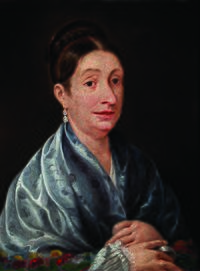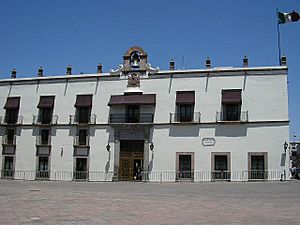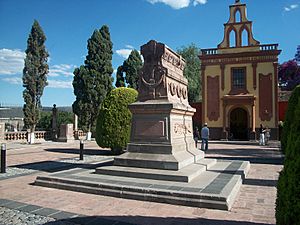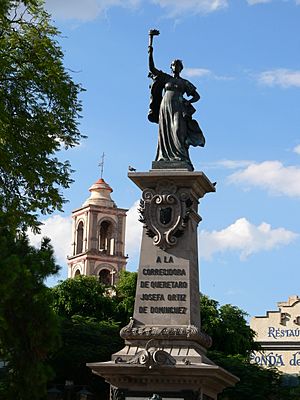Josefa Ortiz de Domínguez facts for kids
Quick facts for kids
Josefa Ortiz de Domínguez
|
|
|---|---|

Posthumous interpretation of Josefa Ortiz, dated 1880.
|
|
| Born |
María Josefa Cresencia
Ortíz y Girón 8 July 1768 |
| Died | 2 March 1829 (aged 55) |
| Body discovered | Mexico City |
| Nationality | Spanish prior to 1821 Mexican after 1821 |
| Other names | La Corregidora |
| Spouse(s) | |
| Children | José Domínguez Ortíz Mariano Domínguez Ortíz Miguel Domínguez Ortiz Ignacia Domínguez Ortíz Micaela Domínguez Ortíz Dolores Domínguez Ortíz Manuela Domínguez Ortíz Magdalena Domínguez Ortiz Camila Domíngueez Ortíz José Domínguez Ortíz |
María Josefa Crescencia Ortiz Téllez–Girón, known as Doña Josefa Ortiz de Domínguez, was a brave woman who helped Mexico gain its independence from Spain. She is often called La Corregidora (which means "the corregidor's wife"). She was born on September 8, 1768, and died on March 2, 1829.
Josefa was married to Miguel Domínguez, who was the "corregidor" (a type of local governor or magistrate) of the city of Querétaro. This is how she got her famous nickname. She is remembered every year during the celebration of the Cry of Dolores, which marked the start of the Mexican War of Independence.
Contents
Early Life and Education
Josefa Ortiz de Domínguez was born in a city then called Valladolid (now Morelia, Michoacán). Her father was a captain in the army, and her mother was Doña Manuela Girón Ortiz. Sadly, Josefa's father died when she was very young. Her mother passed away soon after.
After her parents died, Josefa's older sister, María Sotera Ortiz, took care of her. Her sister helped her get into a respected school called the Colegio de San Ignacio de Loyola Vizcaínas in 1789. While at the school, she met Miguel Domínguez. They got married on January 24, 1791, in Mexico City.
In 1802, Miguel Domínguez was chosen to be the "Corregidor" of Querétaro. This meant he was a high-ranking official. Josefa managed their home and raised their 14 children during this time.
Supporting Independence
Josefa Ortiz de Domínguez felt great sympathy for the Native Mexican, mestizo (people of mixed European and Native American heritage), and criollo (people of Spanish descent born in the Americas) communities. These groups faced unfair treatment from the Spanish government that ruled Mexico. Native people were often treated very badly. Mestizos and criollos were seen as less important and were given fewer opportunities.
This unfairness made many criollos unhappy. They started forming secret groups to discuss new ideas about freedom and rights. These ideas came from the "Enlightenment," a time when people in Europe began to think differently about government and human rights. The Spanish government and the Church had banned many of these ideas.
Josefa attended some of these secret meetings. She eventually convinced her husband to host political gatherings at their home. Important figures like Miguel Hidalgo y Costilla and Ignacio Allende attended these meetings. Soon, these discussions turned into plans for a revolution against Spanish rule.
The Fight for Freedom
The king of Spain, Ferdinand VII of Spain, was overthrown during a war in Europe. This event made many people in Mexico believe it was the perfect time to fight for their own independence. The meetings at Josefa's house became a secret hub for planning the revolution. They gathered weapons and supplies, hiding them in different houses. The start of the revolution was planned for December 8, 1810.
However, on September 13, a supporter betrayed the group. They told the Spanish authorities about the rebel plans in Querétaro. The authorities didn't know that Josefa's husband, the Corregidor, was secretly on the side of the rebels. They asked him to search the town for the rebel leaders. To keep his wife safe and prevent her from warning others, he locked her in her room.
But Josefa was determined. She managed to send a warning through Ignacio Pérez Álvarez, the warden of the royal jail who lived below her. The traditional story says she tapped on the floor with her shoe. Other accounts say she tapped on a shared wall. This warning allowed the rebel leaders to escape the town. It also made Miguel Hidalgo y Costilla start the war earlier than planned. He gave a famous speech, known as the Grito de Dolores ("Cry of Dolores"), on the morning of September 16, 1810. This speech officially began the Mexican War of Independence.
Eventually, Josefa and her husband's involvement in the conspiracy was discovered. They were both arrested and imprisoned separately. Josefa was sent to a monastery in Querétaro, then to Mexico City for trial. Even though her husband tried to defend her as her lawyer, she was found guilty. She was held in different convents because of her strong, rebellious spirit. She was finally released in 1817, after promising not to support the rebellion anymore.
After Independence
After Mexico won its independence in 1822, Agustín de Iturbide became the first Emperor of Mexico. He offered Josefa Ortiz de Domínguez a special role as a lady-in-waiting for his wife. However, Josefa believed that Mexico should be a republic, not an empire. She felt an empire went against the ideals she had fought for. So, she refused the honor. In 1823, she was given the title "woman of honor" by the empress, but she also turned this down.
In her later years, Josefa Ortiz de Domínguez was involved with several political groups that wanted big changes. She always refused any rewards for her part in the independence movement. She believed she was simply doing her duty as a patriot.
Josefa Ortiz de Domínguez passed away in Mexico City in 1829. She was first buried in a convent, but her remains were later moved to Querétaro. The government of Querétaro declared her "Benemérita del Estado," meaning a "distinguished citizen of the state."
Josefa Ortiz de Domínguez has been honored in many ways. In 1910, she and Leona Vicario were the first women to appear on Mexican stamps. Her face was also on the five-centavo coin from 1942 to 1976. In 2010, her image appeared on a special five-peso coin. This coin was part of a series celebrating 200 years of Mexico's independence.
Images for kids
See also
 In Spanish: Josefa Ortiz de Domínguez para niños
In Spanish: Josefa Ortiz de Domínguez para niños








